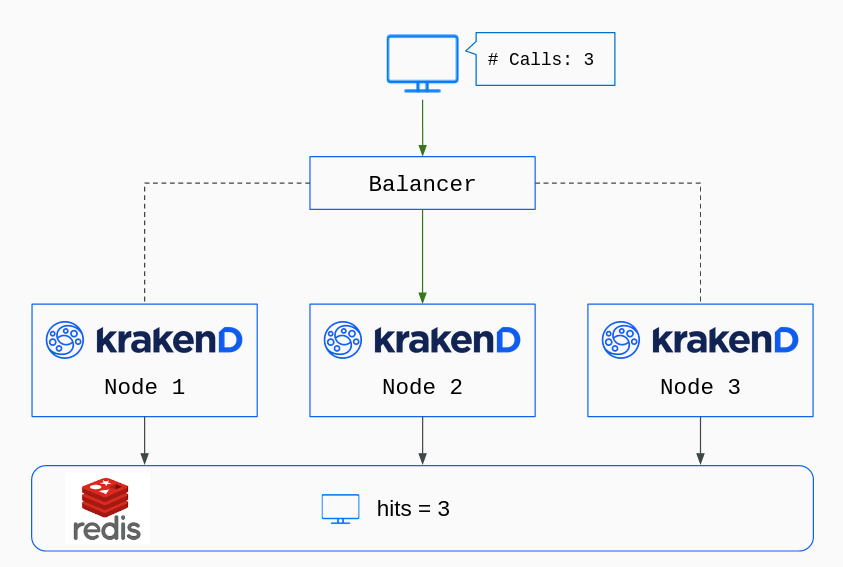Document updated on Dec 12, 2024
Stateful service rate limit (Redis backed)
The Redis rate limit functionality enables a Redis database store to centralize all KrakenD rate limit counters. Instead of having each KrakenD node count its hits in memory, the counters are global and persist in the database.

Rate limit (stateless) vs. Redis-backed rate limit (stateful)
It’s essential to understand the differences between these two antagonistic approaches, so let’s put an example.
Let’s say you have four different KrakenD nodes running in a cluster and want to limit a specific group of users to 100 requests per second.
With the stateless rate limit (qos/ratelimit/service), every KrakenD node only knows about itself. Whatever is happening in the rest of the nodes is not visible to itself. Since you have four KrakenD boxes, you need to write a limit of 25 reqs/s in the configuration. When all nodes run simultaneously and balance equally, you get the average limit of 100 reqs/s. Users can see rejections when the system runs to almost the configured limit’s total capacity. Some nodes will already reach their limit, while others still have a margin. If you ever deploy a 5th machine with the same configuration, your total rate limit upgrades to 125 reqs/s. You are adding 25reqs/s more capacity with the new node. But if you remove instead one of the four nodes, your total rate limit would be 75 reqs/s.
On the other hand, the stateful rate limit (qos/ratelimit/service/redis) uses a shared Redis store by all neighbors, and all nodes are affected and aware of other’s activity. Awareness comes from all KrakenD nodes reading and writing the counters on the central database, knowing the real number of hits on the whole platform. The limits are invariable if you add or remove nodes on the fly.
From a business perspective, the Global rate limit might sound more attractive. In contrast, from an architectural point of view, the default rate limit is much better as it offers infinite scalability, no network dependency, and much higher throughput.
Our recommendation (an engineer writing) is always to use the stateless rate limit.
Configuration
To configure Redis-backed rate limits, you must declare at least two namespaces. One with the Redis configuration and another that sets the rate limit values. The two namespaces could look like this:
{
"$schema": "https://www.krakend.io/schema/v2.11/krakend.json",
"version": 3,
"extra_config": {
"redis": {
"connection_pools": [
{
"name": "shared_instance",
"address": "redis:6379"
}
]
},
"qos/ratelimit/service/redis": {
"connection_pool": "shared_instance",
"on_failure_allow": false,
"max_rate": 10,
"capacity": 10,
"client_max_rate": 10,
"client_capacity": 10,
"every": "1m",
"strategy": "header",
"key": "x-client-id"
}
}
}
The redis namespace allows you to set a lot of Redis pool options. The two basic ones are the name and the address as shown above. Then, the namespace qos/ratelimit/service/redis defines how the Service Rate Limit is going to work. The properties you can set in this namespace are:
Fields of "qos/ratelimit/redis"
Minimum configuration needs any of:
connection_pool
+
max_rate
, or
connection_pool
+
client_max_rate
, or
connection_name
+
max_rate
, or
connection_name
+
client_max_rate
capacityinteger- Defines the maximum number of tokens a bucket can hold, or said otherwise, how many requests will you accept from all users together at any given instant. When the gateway starts, the bucket is full. As requests from users come, the remaining tokens in the bucket decrease. At the same time, the
max_raterefills the bucket at the desired rate until its maximum capacity is reached. The default value for thecapacityis themax_ratevalue expressed in seconds or 1 for smaller fractions. When unsure, use the same number asmax_rate.Defaults to1 client_capacityinteger- Defines the maximum number of tokens a bucket can hold, or said otherwise, how many requests will you accept from each individual user at any given instant. Works just as
capacity, but instead of having one bucket for all users, keeps a counter for every connected client and endpoint, and refills fromclient_max_rateinstead ofmax_rate. The client is recognized using thestrategyfield (an IP address, a token, a header, etc.). The default value for theclient_capacityis theclient_max_ratevalue expressed in seconds or 1 for smaller fractions. When unsure, use the same number asclient_max_rate.Defaults to1 client_max_ratenumber- Number of tokens you add to the Token Bucket for each individual user (user quota) in the time interval you want (
every). The remaining tokens in the bucket are the requests a specific user can do. It keeps a counter for every client and endpoint. Keep in mind that every KrakenD instance keeps its counters in memory for every single client. connection_namestring- The connection pool name or cluster name that is used by this ratelimit. The value must match what you configured in the Redis Connection Pool
connection_poolstring Deprecated- The connection pool name that is used by this ratelimit. The value must match what you configured in the Redis Connection Pool
everystring- Time period in which the maximum rates operate. For instance, if you set an
everyof10mand a rate of5, you are allowing 5 requests every ten minutes.Specify units usingns(nanoseconds),usorµs(microseconds),ms(milliseconds),s(seconds),m(minutes), orh(hours).Defaults to"1s" keystring- Available when using
client_max_rateand you have set astrategyequal toheaderorparam. It makes no sense in other contexts. Forheaderit is the header name containing the user identification (e.g.,Authorizationon tokens, orX-Original-Forwarded-Forfor IPs). When they contain a list of space-separated IPs, it will take the IP from the client that hit the first trusted proxy. Forparamit is the name of the placeholder used in the endpoint, likeid_userfor an endpoint/user/{id_user}.Examples:"X-Tenant","Authorization","id_user" max_ratenumber- Sets the maximum number of requests all users can do in the given time frame. Internally uses the Token Bucket algorithm. The absence of
max_ratein the configuration or a0is the equivalent to no limitation. You can use decimals if needed. on_failure_allowboolean- Whether you want to allow a request to continue when the Redis connection is failing or not. The default behavior blocks the request if Redis is not responding correctlyDefaults to
false strategy- Available when using
client_max_rate. Sets the strategy you will use to set client counters. Chooseipwhen the restrictions apply to the client’s IP address, or set it toheaderwhen there is a header that identifies a user uniquely. That header must be defined with thekeyentry.Possible values are:"ip","header","param"
Migrating from the old Redis plugin (legacy)
Before EE v2.8, an external Redis plugin offered this functionality and is now considered deprecated. The native namespace qos/ratelimit/service/redis replaces this plugin and offers a better way of dealing with stateful functionality.
To migrate, you need to remove the plugin configuration from your settings, and put the values in the new namespace.
Here is a diff example to compare the previous and the new configurations:
< "plugin": {
< "pattern": ".so",
< "folder": "/opt/krakend/plugins/"
< },
< "extra_config": {
< "plugin/http-server": {
< "name": [
< "redis-ratelimit"
< ],
< "redis-ratelimit": {
< "host": "redis:6379",
< "tokenizer": "jwt",
< "tokenizer_field": "sub",
< "burst": 10,
< "rate": 10,
< "period": "60s"
< }
< }
< }
< }
---
> "qos/ratelimit/service/redis": {
> "redis_instance": "shared_instance",
> "on_failure_allow": false,
> "client_max_rate": 10,
> "client_capacity": 10,
> "every": "60s",
> "strategy": "jwt",
> "key": "sub"
> }
The changes you need to do are:
- The
pluginentry can be removed entirely from the configuration if you don’t have other plugins. - Instead of the
plugin/http-serverentry in the serviceextra_config, you must add aredisnamespace that declares the connection pools (now you can have many) - Instead of the
redis-ratelimitfield inside the plugin, you have to declare the new namespaceqos/ratelimit/service/redisunder the serviceextra_config, at the same level than theredisnamespace.
In all, the new Redis configuration should be similar to this:
{
"$schema": "https://www.krakend.io/schema/v2.11/krakend.json",
"version": 3,
"extra_config": {
"redis": {
"nodes": [
{
"name": "shared_instance",
"host": "redis:6379"
}
]
},
"qos/ratelimit/service/redis": {
"redis_instance": "shared_instance",
"on_failure_allow": false,
"max_rate": 10,
"capacity": 10,
"client_max_rate": 10,
"client_capacity": 10,
"every": "60s",
"strategy": "jwt",
"key": "sub"
}
}
}
To see the documentation of the old Redis plugin, browse the documentation for KrakenD Enterprise v2.7 or older.
